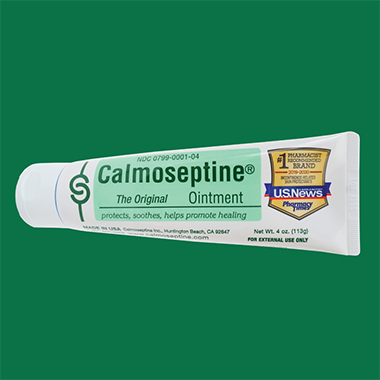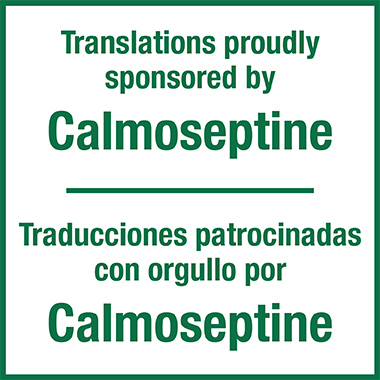Volume 41 Number 4
Hand dermatitis among nurses during the COVID-19 pandemic: frequency and factors
Ayla İrem Aydın, Meryem Atak, Nurcan Özyazıcıoğlu Nurcan and Vahit Dalkızan
Keywords nursing, Wound care, handwashing, COVID-19, dermatitis, hygiene
For referencing Aydın Aİ et al. Hand dermatitis among nurses during the COVID-19 pandemic: frequency and factors. WCET® Journal 2021;41(4):10-14
DOI
https://doi.org/10.33235/wcet.41.4.10-14
Submitted 7 December 2020
Accepted 10 February 2021
Abstract
Objective To determine the frequency of hand dermatitis among nurses during the COVID-19 pandemic and factors affecting its prevalence.
Methods The research sample consisted of 175 nurses working in state hospitals. Research data were collected via Google Survey between October and September 2020. The data were collected using a Sociodemographic Data Collection Form, and a self-assessment form was used to determine dermatologic symptoms.
Results The frequency of hand dermatitis among nurses was 70.9%. A statistically significant difference was found between sex, allergy history, and increased frequency of handwashing and the frequency of hand dermatitis. No significant difference in terms of the frequency of hand dermatitis was found between the nurses who provided care to patients who were COVID-19 positive versus the nurses who did not provide care to patients who were COVID-19 negative. However, the frequency of washing hands and using hand disinfectants and hand creams was found to have increased significantly during the COVID-19 pandemic compared to the prepandemic period.
Conclusions The frequency of hand dermatitis increased among nurses during the pandemic. The increased frequency of handwashing during the pandemic poses a risk for hand dermatitis among nurses, although this should not discourage nurses from appropriate hygiene.
Introduction
The World Health Organisation has declared COVID-19 a global pandemic. According to the latest data, approximately 230 million people have been infected and 4.7 million have died.1 Nonpharmacologic preventive practices such as maintaining social distance, wearing face masks, and washing hands have been recommended to hinder the spread of the virus.2 These practices play an important role in reducing the risk of transmission by preventing the spread of aerosols and protecting vulnerable populations. Studies suggest that hand hygiene is an important prevention strategy for healthcare professionals and societies in places where the pandemic is most prevalent. Hand hygiene remains a critical element of infection control.3-5
The COVID-19 pandemic has also had the effect of reminding nurses about the need for regular hand hygiene with soap, water, or alcohol-based sanitisers. Handwashing is recommended as an inexpensive and common preventive measure to protect oneself from a number of viral infections and prevent disease spread in general.6
Proper handwashing technique is a part of effective hand hygiene.5 The CDC recommends handwashing with soap because it reduces the amount of germs and chemicals on the hands.2 The World Health Organisation (WHO) also recommends handwashing with soap for 40 to 60 seconds using an appropriate technique when hands are noticeably dirty.7 When soap and water are not available, a hand sanitiser with at least 60% alcohol can be used.2 If hands are not visibly soiled, using an alcohol-based hand disinfectant for 20 to 30 seconds with the appropriate technique is preferred to provide hand hygiene.7 Washing hands with an alcohol solution can reduce the risk of infection in medical staff and others in the community by reducing the number of bacteria and viruses on hands.2,8
However, the solutions used, frequency of handwashing, level of moisture, and hand drying process may disrupt the skin barrier and lead to symptoms of hand dermatitis.9-12 Accordingly, the aim of this study was to determine the frequency of hand dermatitis among nurses during the COVID-19 pandemic and the factors affecting its incidence.
Methods
Sample
The research population consisted of nurses working in three different state hospitals in Bursa, Turkey. The research sample consisted of 175 nurses who voluntarily agreed to participate in the study.
Data Collection
The study data were collected by the researchers between September and October 2020 via Google Survey. Data collection tools included two forms prepared by the researchers: one form collected sociodemographic information and the other assessed dermatologic symptoms.
Sociodemographic Data Collection Form. This form consisted of questions about the sex, age, and education level of the nurses who participated in the study, as well as about the hospital and clinic they worked in, and their total years of employment.
Form to Determine Dermatologic Symptoms. This form included questions about allergy history, medication use, the COVID-19 status of the nurse’s patients, frequency of handwashing, and use of hand disinfectants and hand creams. In the last part of the form, nurses were asked to self-assess any dermatologic symptoms specific to hand dermatitis. The form was translated into Turkish by a researcher and a native English speaker. The translations were compared, the most appropriate terminology was selected, and the final version was then translated back into English. The translated text was compared with the original form and revised accordingly. The authors of the study have previously used this self-assessment form with pediatric nurses and nursing students.11,12 The form co-evaluates the symptoms of irritant and allergic contact dermatitis and was designed according to the criteria of Smit et al.13,14 Permission was obtained from Coenraads et al for the use of this form.13,14
Questions were posed about the presence of any of the following symptoms over the last 12 months:
- Scaling and redness on the hands and between the fingers
- Fissures and redness on the hands
- Irritation or itching on hands
- Swelling and redness of the hands
- Vesicles between hands and fingers
Participants who answered “Yes” to one or more of these questions were diagnosed with symptoms of hand dermatitis.
The following questions were also asked:
- Did two or more of these symptoms last longer than 3 weeks?
- Did two or more of these symptoms occur more than once?
Participants who answered “Yes” to either of these questions were diagnosed with recurrent or severe hand dermatitis. The Cronbach α coefficient of the form was 0.888.
Data Analysis
Numeric and percentile distributions were used for sociodemographic data and Mann Whitney U test, Wilcoxon Sign rank test, and Pearson χ2 test were used for comparisons. The SPSS for Windows Version 23.0 of was used for data analysis.
Ethical Considerations
Ethical approval for the research was received from Bursa Uludağ University Health Sciences Research and Publication Ethics Committee (date and decision number: 29.07.2020; 92662996-04). Legal permission was obtained from the relevant health institutions. Consent was obtained from the nurses who participated in the study via the Google Survey.
Results
Table 1 shows the personal characteristics of the nurses participating in the study. The frequency of hand dermatitis among the nurses was 70.9% (124 of 175). The frequency of hand dermatitis was significantly higher in women than in men. The frequency of hand dermatitis was significantly higher among nurses who had a history of allergies compared with those without an allergy (P < .05). The mean age of the nurses participating in the study was 29.14 ± 7.22, and the mean years of employment were 6.68 ± 8.02. No significant difference was found in the frequency of hand dermatitis among nurses by mean age or years of employment. When the incidence of hand dermatitis was examined by unit where the nurses worked, the frequency was higher among nurses working in pediatric (76.1%), surgical (76%), and COVID-19 wards (69.5%). However, no significant difference was found by unit (P > .05).
Table 1. Participant characteristics
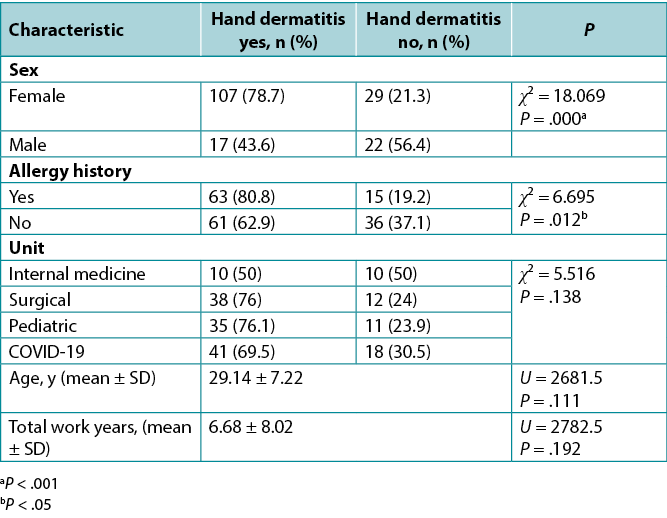
The most frequently reported symptoms were redness and fissures (sharply defined linear tears in the epidermis and dermis; 77.1%), irritation and itching (76%), and scaling/rash (67.4%; Figure 1).
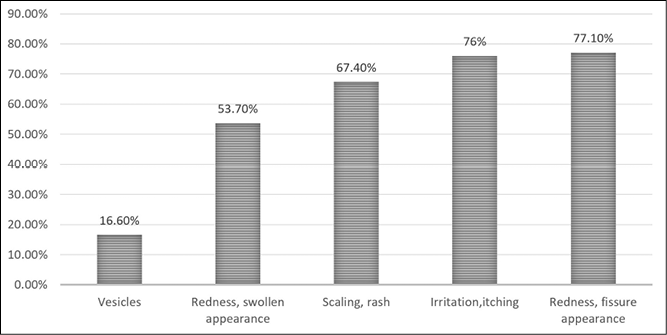
Figure 1. hand dermatitis symptoms
The frequency of hand dermatitis was 71.5% among nurses who provided care to patients who were COVID-19 positive, whereas the frequency of hand dermatitis was 66.7% among nurses who did not provide care to COVID-19 positive patients. This difference was not significant (Table 2).
Table 2. Frequency of hand dermatitis based on whether nurses cared for patients positive for COVID-19
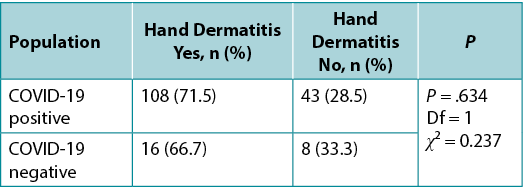
Nurses’ hand hygiene behaviours before and during the COVID-19 pandemic were examined (Table 3). It was determined that the frequency of handwashing per day, the use of disinfectants, and the use of hand cream/moisturiser had increased significantly during the pandemic (P < .001). In terms of handwashing frequency, 48% (84 of 175) of the nurses washed their hands more than 25 times a day. The frequency of hand dermatitis significantly increased with the frequency of handwashing (Table 4; P < .05). The frequency of hand disinfectant and hand cream use did not significantly affect hand dermatitis (P > .05). The most frequently used handwashing substances were liquid soap, liquid soap and alcohol-based gel, chlorhexidine-based gel, and alcohol-based gel (Figure 2).
Table 3. Hand hygiene behaviors of nurses before and during the pandemic

Table 4. Frequency of hand dermatitis by hygiene behavior
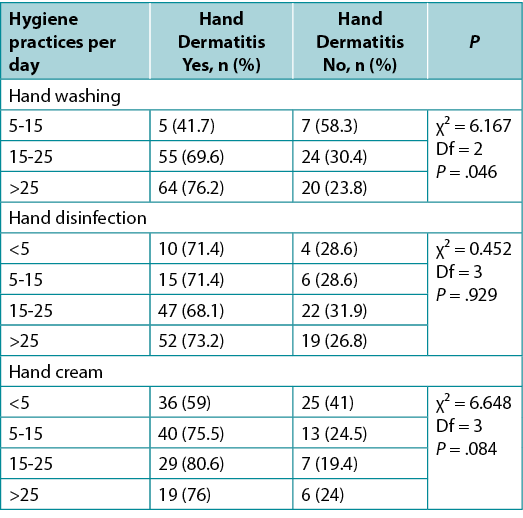
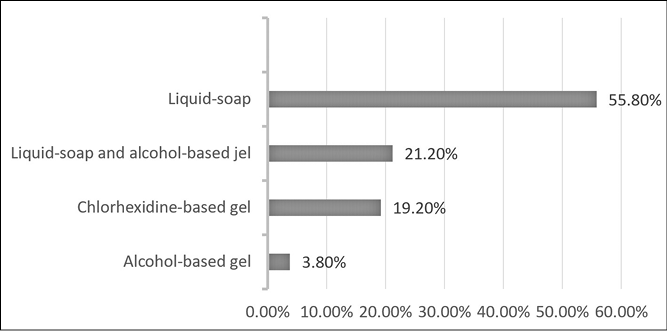
Figure 2. substances used by nurses for handwashing
Discussion
Hand dermatitis is a common disease that can progress either acutely or chronically and has different etiologies.15 In the current study, the frequency of hand dermatitis among nurses during the COVID-19 pandemic was 70.9%. The results of the current study were similar to those obtained in other studies conducted on hand dermatitis in health workers during the COVID-19 pandemic. One study conducted during the pandemic revealed that 84.6% of health workers had unwanted skin reactions on their hands.16 Another study reported that 74.5% of primary health workers had skin damage on their hands.10 A study conducted at the beginning of the pandemic found that 90.4% of health workers had acute symptoms of hand dermatitis.17
In a study conducted before the pandemic in the same region as the current study, 47.5% of the nurses working in pediatric clinics were reported to have hand dermatitis.11 The frequency of hand dermatitis was found to be 12%,18 21%,19,20 and 22.1%21 in other studies conducted before the pandemic. Given these results, it is clear that the frequency of hand dermatitis had increased among health workers during the pandemic.
In this study, the frequency of hand dermatitis was significantly higher in women than in men. Alluhayyan et al22 conducted a study with health workers and found that women were more prone to dermatitis. Likewise, Gupta et al23 found that hand dermatitis was slightly more common in women than in men. However, other studies have reported that sex did not have a significant effect on the frequency of hand dermatitis.12,21
Allergies are abnormal hypersensitivity reactions of the immune system against foreign substances.24,25 This response can be observed in early childhood as well as in adolescence and adulthood.25,26 The frequency of hand dermatitis was significantly higher among nurses who had a history of allergy compared with those without an allergy, which is consistent with previous studies.12,19,21,23 However, Kiely et al27 concluded that a history of allergy did not affect the development of dermatitis, despite reporting that the risk of developing dermatitis was significantly higher in health workers with a history of dermatitis.
One of the most common methods to prevent the spread of viruses is effective hand hygiene. In the fight against COVID-19 it is essential that effective hand hygiene habits are acquired in childhood.28 Kiely et al27 reported that the frequency of handwashing increased among almost all health workers (99.26%) during the pandemic. When the prepandemic and pandemic periods were compared in the current study, the frequency of handwashing and use of hand disinfectants/creams had increased significantly (Table 3). Similarly, Guertler et al17 conducted a study with physicians and nurses and found similar results. All of the guidelines for combating COVID-19 recommend thorough and frequent hand hygiene practices.2,5 Although the increase in the frequency of handwashing is one of the factors that contributes to the development of dermatitis, this should not dissuade health workers from appropriate hand hygiene practices during the pandemic.4
Nurses are the primary caregivers in a medical setting and are thus prone to infection with and transmission of the COVID-19 virus. It is vital that they comply with the guidelines for preventing and controlling infections to fight the pandemic.29
In another study conducted during the pandemic, Lan et al10 concluded that the frequency of hand dermatitis increased significantly in health workers who washed their hands more than 10 times a day. Studies conducted before the pandemic reported a significant relationship between an increased frequency of handwashing and the frequency of hand dermatitis.12,30 However, the present study found no significant difference in the frequency of hand dermatitis by use of hand cream. However, the hand creams used by nurses may not be ideal. The use of skin moisturisers is recommended to maintain healthy skin;31,32 for skin protection, humectants such as topical urea and propylene glycol and occlusive emollients such as petrolatum-based products, lanolin, mineral and vegetable oils, and waxes together are recommended. Concomitant use is beneficial to keep the stratum corneum moist and soothe the skin.33
Conclusions
This study found that the frequency of hand dermatitis among nurses during the pandemic was high. Sex, history of allergy, and increased frequency of handwashing were among the factors increasing hand dermatitis. Hand hygiene increased significantly among health workers during the pandemic. It was also found that nurses increased the measures they took to protect their skin to avoid dermatitis.
Hand disinfection plays an important strategic role in the fight against COVID-19. However, the skin and mucosa barrier are likely to be damaged in nurses who are consistently practicing good hygiene. Nurses should take proper measures to protect their skin while carrying out their duties.
Dermatitis de manos entre el personal de enfermería durante la pandemia del COVID-19: frecuencia y factores
Ayla İrem Aydın, Meryem Atak, Nurcan Özyazıcıoğlu Nurcan and Vahit Dalkızan
DOI: https://doi.org/10.33235/wcet.41.4.10-14
Resumen
Objetivo Determinar la frecuencia de la dermatitis de manos entre el personal de enfermería durante la pandemia del COVID-19 y los factores que afectan a su prevalencia.
Métodos La muestra de la investigación estaba formada por 175 enfermeros que trabajaban en hospitales públicos. Los datos de la investigación se recogieron a través de una encuesta de Google entre octubre y septiembre de 2020. Los datos se recogieron mediante un formulario de recogida de datos sociodemográficos, y se utilizó un formulario de autoevaluación para determinar los síntomas dermatológicos.
Resultados La frecuencia de la dermatitis de manos entre el personal de enfermería fue del 70,9%. Se encontró una diferencia estadísticamente significativa entre el sexo, los antecedentes de alergia y el aumento de la frecuencia del lavado de manos y la frecuencia de la dermatitis de manos. No se encontraron diferencias significativas en cuanto a la frecuencia de dermatitis de manos entre el personal de enfermería que prestó atención a pacientes que eran COVID-19 positivos frente al personal de enfermería que no presto atención a pacientes que eran COVID-19 negativos. Sin embargo, se comprobó que la frecuencia de lavado de manos y de uso de desinfectantes y cremas de manos aumentó significativamente durante la pandemia del COVID-19 en comparación con el periodo prepandémico.
Conclusiones La frecuencia de la dermatitis de manos aumentó entre el personal de enfermería durante la pandemia. El aumento de la frecuencia del lavado de manos durante la pandemia supone un riesgo de dermatitis de manos entre el personal de enfermería, aunque esto no debe desanimar al personal de enfermería a realizar una higiene adecuada.
Introduccion
La Organización Mundial de la Salud ha declarado la COVID-19 como una pandemia mundial. Según los últimos datos, aproximadamente 230 millones de personas se han infectado y 4,7 millones han muerto.1 Se han recomendado prácticas preventivas no farmacológicas, como mantener la distancia social, usar mascarillas y lavarse las manos, para dificultar la propagación del virus.2 Estas prácticas desempeñan un papel importante en la reducción del riesgo de transmisión al evitar la propagación de aerosoles y proteger a las poblaciones vulnerables. Los estudios sugieren que la higiene de las manos es una importante estrategia de prevención para los profesionales sanitarios y las sociedades de los lugares donde la pandemia es más frecuente. La higiene de las manos sigue siendo un elemento fundamental del control de las infecciones.3-5
La pandemia del COVID-19 también ha tenido el efecto de recordar al personal de enfermería la necesidad de una higiene regular de las manos con agua y jabón o con desinfectantes a base de alcohol. El lavado de manos se recomienda como una medida preventiva barata y común para protegerse de una serie de infecciones víricas y evitar la propagación de enfermedades en general.6
Una técnica de lavado de manos adecuada forma parte de una higiene de manos eficaz.5 Los CDC recomiendan el lavado de manos con jabón porque reduce la cantidad de gérmenes y sustancias químicas en las manos.2 La Organización Mundial de la Salud (OMS) también recomienda el lavado de manos con jabón durante 40 a 60 segundos utilizando una técnica adecuada cuando las manos están visiblemente sucias.7 Cuando no se dispone de agua y jabón, se puede utilizar un desinfectante de manos con al menos un 60% de alcohol.2 Si las manos no están visiblemente sucias, es preferible utilizar un desinfectante de manos a base de alcohol durante 20 o 30 segundos con la técnica adecuada para la higiene de las manos.7 Lavarse las manos con una solución alcohólica puede reducir el riesgo de infección en el personal médico y otras personas de la comunidad al reducir el número de bacterias y virus en las manos.2,8
Sin embargo, las soluciones utilizadas, la frecuencia del lavado de manos, el nivel de humedad y el proceso de secado de las manos pueden alterar la barrera cutánea y provocar síntomas de dermatitis de manos.9-12 En consecuencia, el objetivo de este estudio fue determinar la frecuencia de la dermatitis de manos entre el personal de enfermería durante la pandemia del COVID-19 y los factores que afectan a su incidencia.
Metodos
Muestra
La población de la investigación estaba formada por personal de enfermería que trabajaba en tres hospitales públicos diferentes de Bursa (Turquía). La muestra de la investigación estaba formada por 175 enfermeros que aceptaron voluntariamente participar en el estudio.
Recogida de datos
Los datos del estudio fueron recogidos por los investigadores entre septiembre y octubre de 2020 a través de una encuesta de Google. Las herramientas de recogida de datos incluían dos formularios preparados por los investigadores: uno recogía información sociodemográfica y el otro evaluaba los síntomas dermatológicos.
Formulario de recogida de datos sociodemográficos. Este formulario constaba de preguntas sobre el sexo, la edad y el nivel de estudios del personal de enfermería que participo en el estudio, así como sobre el hospital y la clínica en los que trabajaban, y el total de años de empleo.
Formulario para determinar los síntomas dermatológicos. Este formulario incluía preguntas sobre antecedentes de alergias, el uso de medicamentos, el estado del COVID-19 de los pacientes del personal de enfermería, la frecuencia del lavado de manos y el uso de desinfectantes y cremas de manos. En la última parte del formulario, se pidió al personal de enfermería que autoevaluara cualquier síntoma dermatológico específico de la dermatitis de manos. El formulario fue traducido al turco por un investigador y un hablante nativo de inglés. Se compararon las traducciones, se seleccionó la terminología más adecuada y se tradujo la versión final al inglés. El texto traducido se comparó con el original y se revisó en consecuencia. Los autores del estudio han utilizado previamente este formulario de autoevaluación con enfermeros pediátricos y estudiantes de enfermería.11,12 El formulario evalúa conjuntamente los síntomas de la dermatitis de contacto irritante y alérgica y se diseñó según los criterios de Smit et al.13,14 Se obtuvo el permiso de Coenraads et al para el uso de este formulario.13,14
Se plantearon preguntas sobre la presencia de cualquiera de los siguientes síntomas en los últimos 12 meses:
- Descamación y enrojecimiento en las manos y entre los dedos
- Fisuras y enrojecimiento en las manos
- Irritación o picor en las manos
- Hinchazón y enrojecimiento de las manos
- Vesículas entre las manos y los dedos
Los participantes que respondieron "Sí" a una o más de estas preguntas fueron diagnosticados con síntomas de dermatitis de manos.
También se formularon las siguientes preguntas:
- ¿Duraron dos o más de estos síntomas más de 3 semanas?
- ¿Se produjeron dos o más de estos síntomas más de una vez?
Los participantes que respondieron "Sí" a cualquiera de estas preguntas fueron diagnosticados de dermatitis de manos recurrente o grave. El coeficiente α de Cronbach del formulario fue de 0,888.
Analisis de datos
Se utilizaron distribuciones numéricas y percentiles para los datos sociodemográficos y la prueba U de Mann Whitney, la prueba de rango de signos de Wilcoxon y la prueba χ2 de Pearson para las comparaciones. Para el análisis de los datos se utilizó el programa SPSS para Windows versión 23.0.
Consideraciones éticas
La aprobación ética de la investigación se recibió del Comité de Ética de Investigación y Publicación de la Universidad de Bursa Uludağ (fecha y número de decisión: 29.07.2020; 92662996-04). Se obtuvo el permiso legal de las instituciones sanitarias pertinentes. Se obtuvo el consentimiento del personal de enfermería que participo en el estudio a través de la encuesta de Google.
Resultados
La tabla 1 muestra las características personales del personal de enfermería participante en el estudio. La frecuencia de dermatitis de manos entre el personal de enfermería fue del 70,9% (124 de 175). La frecuencia de la dermatitis de manos fue significativamente mayor en las mujeres que en los hombres. La frecuencia de dermatitis de manos fue significativamente mayor entre el personal de enfermería que tenía antecedentes de alergia en comparación con el que no tenía alergia (P < ,5). La edad media del personal de enfermería participante en el estudio fue de 29,14 ± 7,22, y la media de años de trabajo de 6,68 ± 8,02. No se encontraron diferencias significativas en la frecuencia de la dermatitis de manos entre el personal de enfermería según la edad media o los años de empleo. Cuando se examinó la incidencia de la dermatitis de manos según la unidad en la que trabajaba el personal de enfermería, la frecuencia fue mayor entre el personal que trabajaban en las salas de pediatría (76,1%), cirugía (76%) y COVID-19 (69,5%). Sin embargo, no se encontraron diferencias significativas por unidad (P > ,5).
Tabla 1. Características de los participantes

Los síntomas más frecuentes fueron el enrojecimiento y las fisuras (desgarros lineales bien definidos en la epidermis y la dermis; 77,1%), la irritación y el picor (76%), y la descamación/ruptura (67,4%; Figura 1).
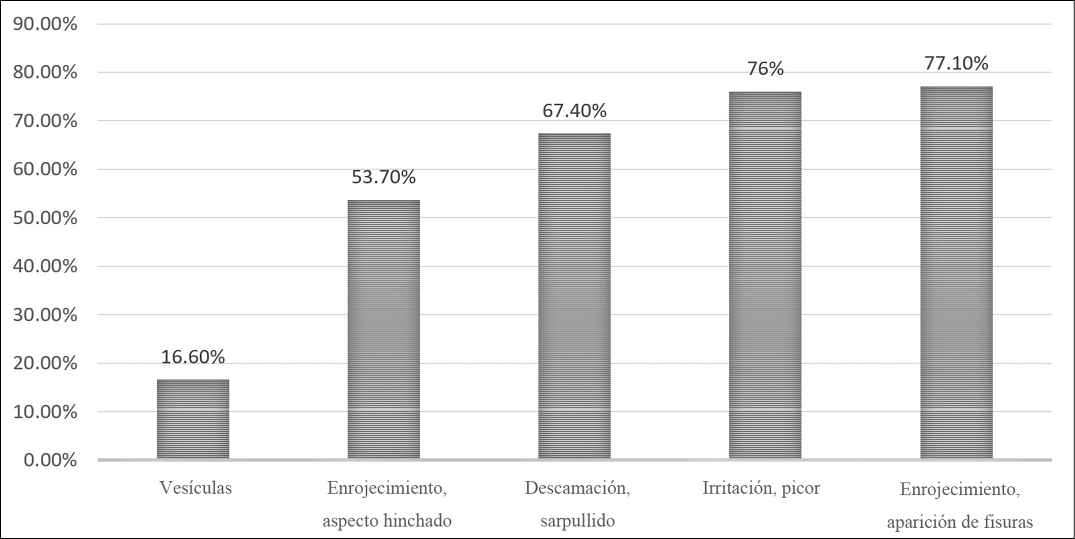
Figura 1. Síntomas de la dermatitis de manos
La frecuencia de dermatitis de manos fue del 71,5% entre el personal de enfermería que prestó atención a pacientes con COVID-19 positivo, mientras que la frecuencia de dermatitis de manos fue del 66,7% entre el personal de enfermería que no prestó atención a pacientes con COVID-19 positivo. Esta diferencia no fue significativa (Tabla 2).
Tabla 2. Frecuencia de dermatitis de manos en función de si el personal de enfermería atendió a pacientes positivos a COVID-19
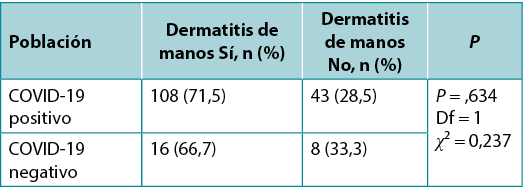
Se examinaron las conductas de higiene de manos del personal de enfermería antes y durante la pandemia del COVID-19 (Tabla 3). Se determinó que la frecuencia de lavado de manos por día, el uso de desinfectantes y el uso de crema/humectante de manos habían aumentado significativamente durante la pandemia (P < ,001). En cuanto a la frecuencia del lavado de manos, el 48% (84 de 175) del personal de enfermería se lavaba las manos más de 25 veces al día. La frecuencia de la dermatitis de manos aumentó significativamente con la frecuencia del lavado de manos (Tabla 4; P < ,5). La frecuencia de uso de desinfectantes y cremas de manos no afectó significativamente a la dermatitis de manos (P > ,5). Las sustancias para el lavado de manos más utilizadas fueron el jabón líquido, el jabón líquido y el gel a base de alcohol, el gel a base de clorhexidina y el gel a base de alcohol (Figura 2).
Tabla 3. Conductas de higiene de manos del personal de enfermería antes y durante la pandemia
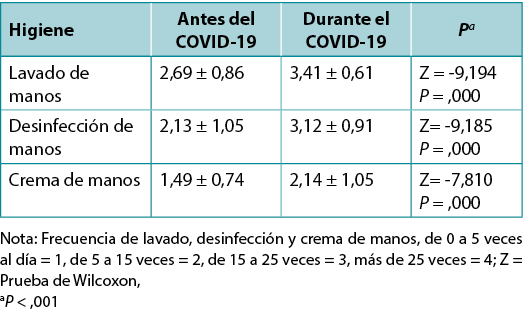
Tabla 4. Frecuencia de la dermatitis de manos según el comportamiento higiénico
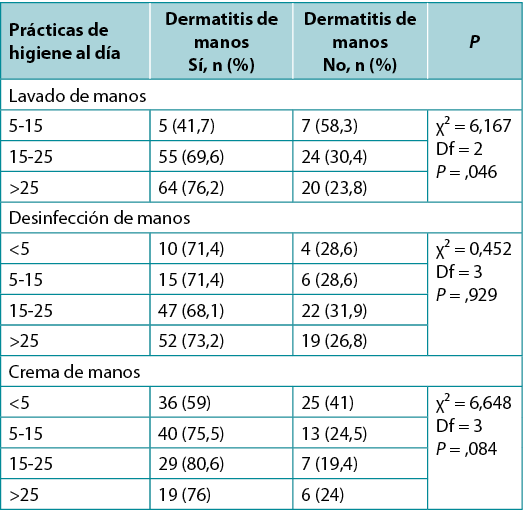
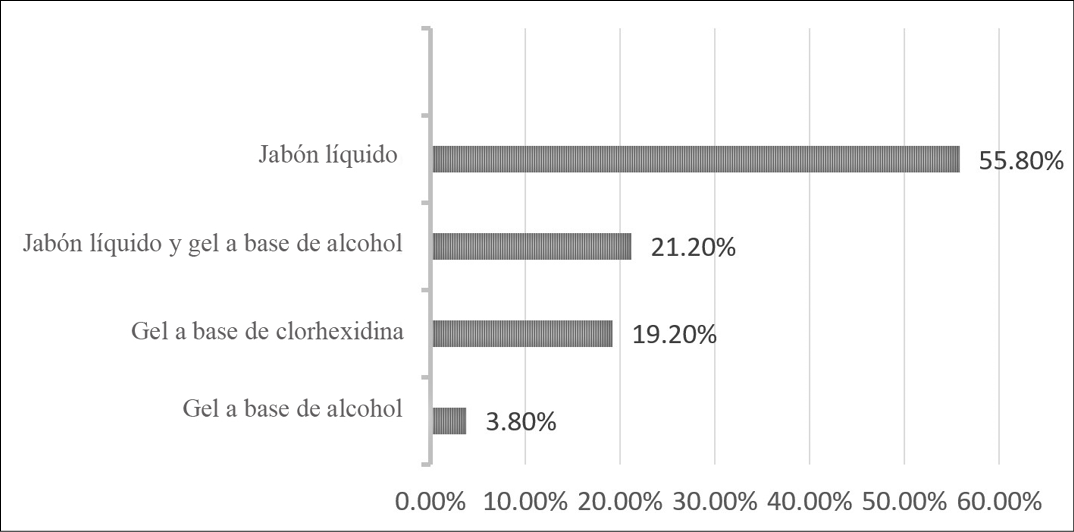
Figura 2. Sustancias utilizadas por el personal de enfermería para el lavado de manos
Discusion
La dermatitis de manos es una enfermedad común que puede progresar de forma aguda o crónica y tiene diferentes etiologías.15 En el estudio actual, la frecuencia de la dermatitis de manos entre el personal de enfermería durante la pandemia del COVID-19 fue del 70,9%. Los resultados del presente estudio fueron similares a los obtenidos en otros estudios realizados sobre la dermatitis de manos en trabajadores sanitarios durante la pandemia del COVID-19. Un estudio realizado durante la pandemia reveló que el 84,6% de los trabajadores sanitarios tenían reacciones cutáneas no deseadas en las manos.16 Otro estudio informó que el 74,5% de los trabajadores de atención primaria tenían daños en la piel de las manos.10 Un estudio realizado al principio de la pandemia descubrió que el 90,4% de los trabajadores sanitarios tenían síntomas agudos de dermatitis de manos.17
En un estudio realizado antes de la pandemia en la misma región que el presente estudio, se informó de que el 47,5% del personal de enfermería que trabajaba en clínicas pediátricas tenían dermatitis de manos.11 La frecuencia de la dermatitis de manos fue del 12%,18 21%,19,20 y 22,1%21 en otros estudios realizados antes de la pandemia. Teniendo en cuenta estos resultados, está claro que la frecuencia de la dermatitis de manos había aumentado entre los trabajadores sanitarios durante la pandemia.
En este estudio, la frecuencia de la dermatitis de manos fue significativamente mayor en las mujeres que en los hombres. Alluhayyan et al22 realizaron un estudio con trabajadores sanitarios y descubrieron que las mujeres eran más propensas a la dermatitis. Asimismo, Gupta et al23 descubrieron que la dermatitis de manos era ligeramente más frecuente en las mujeres que en los hombres. Sin embargo, otros estudios han informado de que el sexo no tuvo un efecto significativo en la frecuencia de la dermatitis de manos.12,21
Las alergias son reacciones anormales de hipersensibilidad del sistema inmunitario frente a sustancias extrañas.24,25 Esta respuesta puede observarse tanto en la primera infancia como en la adolescencia y la edad adulta.25,26 La frecuencia de dermatitis de manos fue significativamente mayor entre el personal de enfermería que tenía antecedentes de alergia en comparación con las que no los tenían, lo que coincide con estudios anteriores.12,19,21,23 Sin embargo, Kiely et al27 concluyeron que los antecedentes de alergia no afectaban al desarrollo de la dermatitis, a pesar de informar de que el riesgo de desarrollar dermatitis era significativamente mayor en los trabajadores sanitarios con antecedentes de dermatitis.
Uno de los métodos más comunes para prevenir la propagación de los virus es la higiene eficaz de las manos. En la lucha contra el COVID-19 es esencial que se adquieran hábitos eficaces de higiene de manos en la infancia.28 Kiely et al27 informaron de que la frecuencia del lavado de manos aumentó entre casi todos los trabajadores sanitarios (99,26%) durante la pandemia. Cuando se compararon los periodos prepandémico y pandémico en el presente estudio, la frecuencia del lavado de manos y el uso de desinfectantes/cremas de manos había aumentado significativamente (Tabla 3). Del mismo modo, Guertler et al17 realizaron un estudio con médicos y enfermeros y encontraron resultados similares. Todas las directrices para combatir el COVID-19 recomiendan prácticas de higiene de manos minuciosas y frecuentes.2,5 Aunque el aumento de la frecuencia del lavado de manos es uno de los factores que contribuyen al desarrollo de la dermatitis, esto no debe disuadir a los trabajadores sanitarios de realizar prácticas adecuadas de higiene de manos durante la pandemia.4
El personal de enfermería es el principal cuidador en un entorno médico y, por lo tanto, es propenso a infectarse con el virus del COVID-19 y a transmitirlo. Es fundamental que cumplan las directrices de prevención y control de las infecciones para luchar contra la pandemia.29
En otro estudio realizado durante la pandemia, Lan et al10 llegaron a la conclusión de que la frecuencia de la dermatitis de manos aumentaba significativamente en los trabajadores sanitarios que se lavaban las manos más de 10 veces al día. Los estudios realizados antes de la pandemia informaron de una relación significativa entre el aumento de la frecuencia del lavado de manos y la frecuencia de la dermatitis de manos.12,30 Sin embargo, el presente estudio no encontró ninguna diferencia significativa en la frecuencia de la dermatitis de manos por el uso de crema de manos. Sin embargo, las cremas de manos que utiliza el personal de enfermería pueden no ser las ideales. Se recomienda el uso de humectantes cutáneos para mantener la piel sana;31,32 para la protección de la piel, se recomiendan humectantes como la urea tópica y el propilenglicol y emolientes oclusivos como los productos a base de petrolato, lanolina, aceites minerales y vegetales, y ceras en conjunto. Su uso concomitante es beneficioso para mantener el estrato córneo húmedo y calmar la piel.33
Conclusiones
Este estudio descubrió que la frecuencia de la dermatitis de manos entre el personal de enfermería durante la pandemia fue alta. El sexo, los antecedentes de alergia y la mayor frecuencia de lavado de manos fueron algunos de los factores que aumentaron la dermatitis de manos. La higiene de las manos aumentó significativamente entre los trabajadores sanitarios durante la pandemia. También se comprobó que el personal de enfermería aumentaba las medidas de protección de la piel para evitar la dermatitis.
La desinfección de las manos desempeña un importante papel estratégico en la lucha contra el COVID-19. Sin embargo, es probable que la barrera de la piel y la mucosa se dañe en el personal de enfermería que practica constantemente una buena higiene. El personal de enfermería debe tomar las medidas adecuadas para proteger su piel mientras desempeñan sus funciones.
Author(s)
Ayla İrem Aydın*
MSc, RN
Research Assistant, Department of Pediatric Nursing, Faculty of Health Sciences, Bursa Uludağ University, Turkey
Meryem Atak
MSc, RN
Research Assistant, Department of Pediatric Nursing, Faculty of Health Sciences, Bursa Uludağ University, Turkey
Nurcan Özyazıcıoğlu Nurcan
PhD, RN
Professor, Dean of Faculty of Health Sciences
Department of Pediatric Nursing, Faculty of Health Sciences, Bursa Uludağ University, Turkey
Vahit Dalkızan
RN
Nurse in the ICU, Ministry of Health Bursa City Hospital, Turkey
* Corresponding author
References
- World Health Organization. Coronavirus disease (COVID-19) pandemic. 2021. www.who.int/emergencies/diseases/novel-coronavirus-2019. Last accessed September 27, 2021.
- Centers for Disease Control & Prevention. Coronavirus Disease 2019 (COVID-19). June 2021. www.cdc.gov/coronavirus/2019-ncov/prevent-getting-sick/hand-sanitizer.html. Last accessed June 25, 2021.
- Aiello AE, Perez V, Coulborn RM, Davis BM, Uddin M, Monto AS. Facemasks, hand hygiene, and influenza among young adults: a randomized intervention trial. PloS One 2012;7:e29744.
- Sibbald RG, Ayello EA. Hand dermatitis, hand hygiene, and healthcare professionals. Adv Skin Wound Care 2020;33:175.
- World Health Organization. WHO save lives: Clean your hands. May 2020. www.who.int/docs/default-source/infection-prevention-and-control/clean-hands-2020/advocacy-slides-2020-long-version.pdf. Last accessed October 1, 2021.
- Townsend J, Greenland K, Curtis V. Costs of diarrhoea and acute respiratory infection attributable to not handwashing: the cases of India and China. Trop Med Int Health 2017;22:74-81.
- World Health Organization. Coronavirus disease (COVID-19) advice for the public. June 2021. www.who.int/emergencies/diseases/novel-coronavirus-2019/advice-for-public. Last accessed June 25, 2021.
- Maliyar K, Sibbald C, Pope E, Gary Sibbald R. Diagnosis and management of atopic dermatitis: a review. Adv Skin Wound Care 2018;31:538–50.
- Al Badri FM. Surgical mask contact dermatitis and epidemiology of contact dermatitis in healthcare workers. Curr Allergy Clin Immunol 2017;30:183-8.
- Lan J, Song Z, Miao X, et al. Skin damage among health care workers managing coronavirus disease-2019. J Am Acad Dermatol 2020;82:1215-6.
- Özyazıcıoğlu N, Sürenler S, Tanrıverdi G. Hand dermatitis among paediatric nurses. J Clin Nurs 2010;19:1597-603.
- Özyazicioglu N, Sürenler S, Aydin AI, Atak M. Hand dermatitis in nursing students. Adv Skin Wound Care 2020;33:213-6.
- Smit HA, Coenraads PJ, Lavrijsen PM, Nater JP. Evaluation of a self-administered questionnaire on hand dermatitis. Contact Dermatitis 1992;26:11–6.
- Smit HA, Burdorf A, Coenraads PJ. Prevalence of hand dermatitis in different occupations. Int J Epidemiol 1993;22:288–93.
- Alavi A, Skotnicki S, Sussman G, Sibbald RG. Diagnosis and treatment of hand dermatitis. Adv Skin Wound Care 2012;25:371-80.
- Lin P, Zhu S, Huang Y, et al. Adverse skin reactions among healthcare workers during the coronavirus disease 2019 outbreak: a survey in Wuhan and its surrounding regions. Br J Dermatol 2020;183:190-2.
- Guertler A, Moellhoff N, Schenck TL, et al. Onset of occupational hand eczema among healthcare workers during the SARS-CoV-2 pandemic: Comparing a single surgical site with a COVID-19 intensive care unit. Contact Dermatitis 2020;83:108-14.
- van der Meer EW, Boot CR, van der Gulden JW, Jungbauer FH, Coenraads PJ, Anema JR. Hand eczema among healthcare professionals in the Netherlands: prevalence, absenteeism, and presenteeism. Contact Dermatitis 2013;69:164-71.
- Ibler KS, Jemec GB, Flyvholm MA, Diepgen TL, Jensen A, Agner T. Hand eczema: prevalence and risk factors of hand eczema in a population of 2274 healthcare workers. Contact Dermatitis 2012;67:200-7.
- Hamnerius N, Svedman C, Bergendorff O, Björk J, Bruze M, Pontén A. Wet work exposure and hand eczema among healthcare workers: a cross-sectional study. Br J Dermatol 2018;178:452-61.
- Luk NM, Lee HC, Luk CK, et al. Hand eczema among Hong Kong nurses: a self-report questionnaire survey conducted in a regional hospital. Contact Dermatitis 2011;65:329-35.
- Alluhayyan OB, Alshahri BK, Farhat AM, et al. Occupational-related contact dermatitis: prevalence and risk factors among healthcare workers in the Al’Qassim Region, Saudi Arabia during the COVID-19 pandemic. Cureus 2020;12:e10975.
- Gupta SB, Gupta A, Shah B, et al. Hand eczema in nurses, nursing auxiliaries and cleaners- a cross-sectional study from a tertiary hospital in western India. Contact Dermatitis 2018;79:20-5.
- American Academy of Allergy, Asthma & Immunology. Allergies. 2021. www.aaaai.org/conditions-and-treatments/allergies. Last accessed June 25, 2021.
- Hopp RJ. Hypersensitivity reactions: an everyday occurrence in pediatric allergy clinics. Pediatr Allergy Immunol Pulmonol 2020;33:12-8.
- Czarnowicki T, He H, Krueger JG, Guttman-Yassky E. Atopic dermatitis endotypes and implications for targeted therapeutics. J Allergy Clin Immunol 2019;143:1–11.
- Kiely LF, Moloney E, O’Sullivan G, Eustace JA, Gallagher J, Bourke JF. Irritant contact dermatitis in healthcare workers as a result of the COVID-19 pandemic: a cross-sectional study. Clin Exp Dermatol 2021;46(1):142-4.
- Borch L, Thorsteinsson K, Warner TC, et al. COVID-19 reopening causes high risk of irritant contact dermatitis in children. Dan Med J 2020;67:A05200357.
- Lotfinejad N, Peters A, Pittet D. Hand hygiene and the novel coronavirus pandemic: the role of healthcare workers. J Hosp Infect 2020;105:776-7.
- Zhang D, Zhang J, Sun S, Gao M, Tong A. Prevalence and risk factors of hand eczema in hospital-based nurses in northern China. Australas J Dermatol 2018;59:e194-7.
- Yan Y, Chen H, Chen L, et al. Consensus of Chinese experts on protection of skin and mucous membrane barrier for health-care workers fighting against coronavirus disease 2019. Dermatol Ther 2020;33:e13310.
- Gupta MK, Lipner SR. Hand hygiene in preventing COVID-19 transmission. Cutis 2020;105:233-4.
- Beiu C, Mihai M, Popa L, Cima L, Popescu MN. Frequent hand washing for COVID-19 prevention can cause hand dermatitis: management tips. Cureus 2020;12:e7506.


